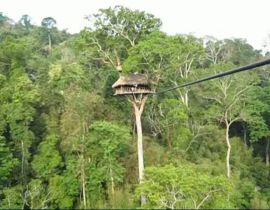Bokeo Overview
Situated in the heart of the golden triangle, Bokeo is just over the border from Chiang Rai province in Thailand and also borders Myanmar while China is less than 100km away. Although Bokeo is the smallest province in Laos, it harbours a large number of interesting minority groups (approximate 30 ethnicities). The province split off from Luang Nam Tha and was created in 1983. The name Bokeo translates as ‘gem mine’ and the city is known as the ‘land of sapphires’. Panning for gold, and digging for precious stones is a major occupation here.
HuayXai, the capital provincial of Bokeo, sits on the bank of the Mekong River. Like most minor cities in Laos, several temples built in earlier centuries and surrounding villages seem to be the only attractions. However, Bokeo’s real economic strength is tourism. A holiday among a network of hunts and shelters built on top of trees in primary monsoon dry deciduous forest is a decidedly appealing one. A perfect spot where one can observe the forest’s rare habitants from above. Besides fascinating attractions and delightful activities, HouayXai is also known as the gateway to explore the rest of Laos, a famous stopover spot for most arrivals before boarding a boat and heading southeast to Pak Beng and LuangPrabang. A trip up north on Bokeo’s winding and bumpy roads will lead to LuangNamtha and beyond.
Over the centuries, Bokeo has remained an important stopover for Chinese traders traveling by boats between China and Thailand. Nowadays, the only connection between Bokeo and Chiang Rai is via ferry and speedboat. However, a bridge between Laos and Thailand is scheduled to open in 2012.
All tourist attractions around HuayXai can be seen on foot within a day. Observe the view from the top of the Chinese-styled temple, JomKhaoManilat, the most important local sacred place. It’s not to be missed and why not have a look at the stunning French-built Fort Carnot. Both sitesare located near the ferry crossing pier HuayXai Chiang Kong.











